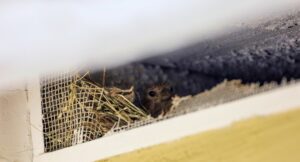How Birds Get Into Vents and How to Remove Them
Birds are a common sight around homes and buildings, and they often seek shelter in vents. Unfortunately, birds can cause damage to vents and create potential health hazards by leaving behind debris, feces, and nesting materials. If you suspect that there are birds inside your vents, it’s important to take action to remove them safely and prevent them from coming back.

How Do Birds Get Into Vents?
Birds can get into vents in a variety of ways. They may be attracted to the warmth and shelter that vents provide, or they may be seeking a place to build a nest. In some cases, birds may accidentally fly into vents while in search of food or water. They can also enter vents through small openings, such as gaps in the vent cover or damaged parts of the vent system. Lastly, they may also enter through the ductwork, which can provide them with access to different parts of the vent system.
Removing Birds from Vents
If you suspect that birds are living in your vents, it’s important to take action to remove them safely. Here are some steps for safely removing them from your vents:
- Inspect the vents: Start by inspecting the vents to determine the extent of the problem. Look for signs of bird activity, such as nesting materials, droppings, or feathers. You may also hear chirping or scratching noises coming from the vents.
- Turn off the HVAC system: Before attempting to remove the birds, turn off your HVAC system to prevent them from being harmed by moving air.
- Wear protective gear: When removing birds from vents, it’s important to wear protective gear to prevent exposure to bird droppings and other hazards. This includes gloves, a face mask, and safety goggles.
- Remove the birds: There are several methods for removing birds from vents. One option is to use a vacuum system designed for bird removal, which can safely suction the birds out of the vents. Another option is to use a trap-and-release method, where you capture the birds in a humane trap and release them outside.
- Clean the vents: Once the birds have been removed, it’s important to clean the vents thoroughly to remove any debris or nesting materials that may be left behind. Use a vacuum with a HEPA filter to prevent the spread of dust and other contaminants.
How to Prevent Birds from Coming Back
After removing birds from your vents, it’s important to take steps to prevent them from returning, such as:
Installing vent covers: Installing vent covers can prevent birds from accessing the vents in the first place. Choose covers with small mesh openings that can prevent birds from entering.
Sealing any gaps: Seal any gaps or cracks in the vent system to prevent birds from entering through damaged parts.
Trimming nearby trees and bushes: Trees and bushes near your home can provide birds with easy access to your vents. Keeping them trimmed makes it more difficult for birds to reach the vents.
Using bird deterrents: There are a variety of bird deterrents available that can discourage birds from roosting on or near your home. These include visual deterrents, such as scarecrows or reflective tape, and sonic deterrents, such as bird alarms.
Leave it to the Professionals
Removing birds from vents is always best left to the professionals, such as the ones at Bay Area Wildlife Solutions. That’s because we have the necessary training, techniques, and equipment to safely and humanely remove birds from vents all in record time. Don’t worry about researching how to safely remove birds from the attic anymore; contact Bay Area Wildlife now!

 302.500.0181
302.500.0181  410.829.6368
410.829.6368